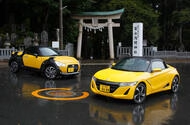Why Is Europe Considering a New E-Car Category for Small, Affordable Cars?
If you’ve been following the buzz around the European car industry lately, you’ve probably heard whispers about a new “E-car” category. But what’s really driving this push for a fresh class of small, affordable vehicles? It comes down to a mix of economic pressure, environmental goals, and some healthy competition—especially from China.
European automakers are facing a crossroads. On one hand, strict regulations are pushing them to phase out new internal combustion engine (ICE) cars by 2035. On the other, Chinese manufacturers are flooding the market with budget-friendly electric vehicles, threatening Europe’s homegrown brands. The result? A real need for innovation—and fast.
Industry leaders like John Elkann of Stellantis and former Renault Group boss Luca de Meo have floated the idea of a new class of small cars with fewer regulatory hurdles. The goal: make them cheaper to build, more eco-friendly over their entire lifecycle, and—crucially—affordable for everyday Europeans. This isn’t just about keeping up with the Joneses; it’s about ensuring millions of jobs and the future of Europe’s auto industry.
What Can Europe Learn from Japan’s Kei Car Success?
Japan’s kei car class has been a quiet powerhouse since 1949, making up about 40% of the Japanese domestic market. These pint-sized vehicles are beloved for their efficiency, affordability, and clever use of space. They’re not just city runabouts—they’re a cultural icon.
So, what’s the secret sauce? Kei cars benefit from lighter regulations, which means lower production costs and more flexibility for manufacturers. They’re also subject to tax breaks and other incentives, making them a smart choice for budget-conscious consumers.
European leaders are taking notes. The proposed E-car category borrows heavily from the kei car playbook, aiming to create a similar sweet spot for small, practical vehicles in Europe. The hope is that by easing up on some of the more stringent (and expensive) safety and emissions rules—without compromising on core safety—manufacturers can deliver cars that are both wallet- and planet-friendly.
How Are Industry Leaders and Policymakers Responding to the Challenge?
The recent Munich Motor Show was a wake-up call. Heavyweights like François Provost (Renault), Oliver Zipse (BMW), and Jean-Philippe Imparato (Stellantis) all sounded the alarm: without urgent action, Europe risks losing its edge to aggressive Chinese competitors.
One big idea on the table? Shifting the focus from just tailpipe emissions to the entire lifecycle CO2 footprint of vehicles. This would give automakers more leeway to experiment with different powertrains—think hybrids, plug-in hybrids, and even alternative fuels—while still meeting tough climate targets.
European Commission President Ursula von der Leyen has thrown her weight behind the E-car initiative. In her State of the Union address, she called the car industry “a pillar of our economy and industry,” and stressed the need for small, affordable vehicles built in Europe, for Europeans. Her vision is clear: E for environmental, E for economical, and E for European.
What Powertrains Will the New E-Car Class Allow?
Here’s where things get interesting—and a little uncertain. The specifics of what powertrains will be allowed in the new E-car class are still up in the air. Will it be all-electric, or will hybrids and other low-emission options get a seat at the table?
Von der Leyen has made it clear that “the future is electric, and Europe will be part of it.” But industry voices are pushing for a broader approach, arguing that a mix of technologies could help speed up the transition while keeping cars affordable. Expect plenty of debate (and lobbying) as the details get hammered out.
Why Does This Matter for Everyday Drivers?
Let’s face it: new cars are getting pricier, and many Europeans are feeling squeezed. The average price of a new car in Europe has climbed steadily, with electric vehicles often costing even more upfront. According to the European Automobile Manufacturers’ Association (ACEA), affordability is now one of the top concerns for car buyers.
A new E-car category could be a game-changer. By cutting production costs and focusing on the essentials, automakers could offer genuinely affordable options—without sacrificing quality or sustainability. For city dwellers, young drivers, or anyone looking to downsize, this could open up a whole new world of choices.
Could Europe’s E-Car Plan Really Compete with China?
China’s rapid ascent in the electric vehicle market is no accident. With strong government support, streamlined regulations, and a relentless focus on affordability, Chinese brands have quickly become global contenders. In 2023, Chinese EV exports to Europe surged, catching some European manufacturers off guard.
The proposed E-car category is Europe’s answer—a way to level the playing field and keep production (and jobs) at home. By investing in local supply chains and focusing on European-built vehicles, the EU hopes to fend off the competition and maintain its leadership in automotive innovation.
What’s Next for Europe’s Small Car Revolution?
Big changes are rarely easy, and the road ahead is full of questions. How will safety standards be balanced with cost-cutting? Can European automakers move quickly enough to outpace their rivals? And will consumers embrace a new generation of small, efficient cars?
One thing’s clear: the conversation is just getting started. With policymakers, industry leaders, and everyday drivers all weighing in, the future of Europe’s car market is being shaped right now. If the E-car category lives up to its promise, it could spark a renaissance in affordable, sustainable mobility—one that puts Europe back in the driver’s seat.
For anyone who cares about the future of driving, this is a story worth watching. The outcome? It could be game-changing.

